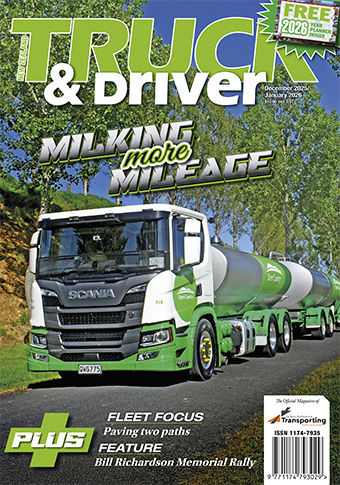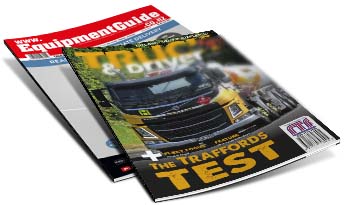Southpac Legends


Ian Emmerson
Southpac Legends
During a lifetime working in the trucking industry, Ian Emmerson has developed a strong philosophy that, while competition is vital to driving business efficiency, just as much can be gained from cooperation – between transport operators and their customers, and between industry groups.
This month’s Southpac Legend also admits to being passionate about the engineering side of the business, in terms of specifying and setting up units for optimal efficiency and suitability for their jobs.
To this end he was very active in the industry group that worked with government agencies to develop what became the HPMV regulations in the early 2010s.
Early, and successful, products of the group’s work were the 11-axle Super-B Emmerson Transport curtainsiders carting palletised export wood pulp from Pan Pac at Whirinaki to Port Napier. Running to a 62t permit gave the units a payload capability of 40t, double that of a standard 44t GCM combination.
...During a lifetime working in the trucking industry, Ian Emmerson has developed a strong philosophy that, while competition is vital to driving business efficiency, just as much can be gained from cooperation – between transport operators and their customers, and between industry groups.
This month’s Southpac Legend also admits to being passionate about the engineering side of the business, in terms of specifying and setting up units for optimal efficiency and suitability for their jobs.
To this end he was very active in the industry group that worked with government agencies to develop what became the HPMV regulations in the early 2010s.
Early, and successful, products of the group’s work were the 11-axle Super-B Emmerson Transport curtainsiders carting palletised export wood pulp from Pan Pac at Whirinaki to Port Napier. Running to a 62t permit gave the units a payload capability of 40t, double that of a standard 44t GCM combination.
Born and raised in Hastings, Ian decided at 15 he’d had enough of schooling and started to work full-time on the family’s process cropping and horticulture property. He gained his truck and trailer licence at 18, not a big deal he admits, for he had been driving a variety of machinery on the farm long before that. The family had its own trucks, and in 1978 branched out into the commercial side with the formation of Emmerson Transport.
This side of the business grew rapidly, and the farming was downsized and consolidated into apple growing.
Ian and his brother Peter helped their father John on the transport venture. In common with most fledgling transport businesses of the era, the company relied initially on TK Bedfords.
“After that, for a time our mainstay linehaul truck was a 250 A-Series ERF, and then we ventured into Internationals, 3070s and T-Lines. I did a lot of my driving in Inters.
“The company expanded dramatically in the wake of deregulation during the late 1980s and early 1990s. What had started primarily to cart our own export produce to the ports of Tauranga and Auckland grew to include livestock and rural work and after that, general freight.
“Peter stayed more hands-on with the driving, while in the mid-1990s late 1980s I shifted into a management role. By that time, I had put up around a million kilometres on the road.”
In that era the company moved out of livestock and was rebranded ETL. Growth continued, and by the mid-2010s the company was the biggest general freight transport operator in the Hawkes Bay and had six depots across the North Island.
In early 2021, ETL was sold to Chester Perry Securities, with Ian has staying on as a director and business consultant. He says the sale has allowed ETL to grow and take on new opportunities: “I didn’t want to load my son Shaun and daughter Karly up with the responsibility for a major company, which can be a real minefield to handle.
“The transport industry isn’t as simple as it looks. It’s quite complex, and the passion of younger people to be involved is not as keen as it was 40 years ago. In addition, the industry has gone from a relatively low level of regulation to a high level of compliance, and that does put people under more pressure.
“The senior team with ETL now are doing a very good job. The current situation means the company has the backing to expand. During our years of maximum growth, we were expanding up to 25% per year, which meant we were always in capital debt with equipment.
“The margins were enough to support this in those days, but a lot of the margin has now disappeared from the industry, which makes it more of a challenge. One positive now is that the stakeholders have a greater capacity to invest in capital outlay.”
He’s proud of Emmerson Transport’s involvement in the introduction of HPMV vehicles.
“It gave our customers and ourselves more margin to play with. The country as a whole gained, too, for it gave us the opportunity to shift a greater tonnage with the same equipment, reducing vehicle movements. Everyone benefited.”
The consolidation and streamlining of the Road Transport Association and Transporting NZ over the past few tears years has meant a welcome reduction in Ian’s responsibilities on the boards of these bodies, he says: “Reducing the number of regions in the RTA has led to greater efficiencies, without limiting their ability to be heard.
“The regional structure is important for rural carriers, because the issues faced by firms in the Waikato, for example, can be quite different from those in Southland, and different again in the cities, so it’s vital that these varying concerns can be tabled. Often, a regional issue can be handled at that local level.”
Then there’s the social aspect: “Operators might fight like the Devil on the front line, but a lot of good come from being able to get together occasionally for a beer and a yarn.
“In a wider context, my vision is to see the road transport industry represented by a single entity, with a uniform membership across the country, rather than what we have now, with several groups, not always working together, unfortunately.
“Unless we can present a single voice to government and regulatory authorities the message will always be confusing.”
Ian reckons he has progressively worked to be a little more than simply truck mad, pointing to years playing squash and a keen interest in rugby. He and wife Sue also enjoy travelling, heading to Europe every couple of years pre-Covid.
He also has a classic project truck, a 1984 International Eagle 4870 that came out of the ETL fleet and was the last truck he drove when he was still on the road. It’s one of the few 8x4 versions of the model, and Ian believes it’s the only one that’s been in single ownership all its life. The truck has a 400hp Cummins 855, a 15-speed Roadranger and Rockwell diffs.
The Eagle has done about three million kilometres. About half a million ago it was fitted with a brand-new crate engine, one of several imported by Cummins NZ to clear old stock from the USA.
The project is around 75% completed, Ian says, but has been put on hold while he builds a new workshop. Finished, the model will be a flat-deck, a configuration it used for its first decade of service.
Expanding on his passion for developing optimal specs for units, Ian says customers play a big part in the process.
“There has to be a level of loyalty and trust when you’re selling a concept to them. You’ve got to have faith in each other, be prepared to work as a partnership. For primary producers especially, transport is one of their bigger costs. If you get it wrong, it will impact both of you. We have been more involved in perishable and time-sensitive products than manufactured goods, where even a few hours can get you out of step.
“One of the things we’ve tried to do with ETL is where we have a long-term association with a customer with, say, three truck and trailer units dedicated to the contract, we make the costs transparent and aim for a fair return on investment.
“You can’t do it for all products, but if it can be achieved it can work as a partnership. Sometimes, though, the costs can be driven by the internal efficiencies of the customer, putting them outside the ability of the transport operator to control.
“This model can assist though transparency to highlight areas that the customer can aid in cost control by changing some of their internal practices to achieve better efficiency, making the practice a win for both parties.
“I’ve always had a lifelong philosophy of not asking people to do anything I won’t do myself. It’s also important to put effort back into the community that feeds us, hence the involvement in the Life Education Trust and other local support groups.”
Via an annual ‘Ride in a Truck’ day, ETL has also supported a local trust that provides accommodation to families with children in hospital. Ian has been a chair on that for more than 20 years.



 + EQUIPMENT GUIDE - FREE
+ EQUIPMENT GUIDE - FREE
